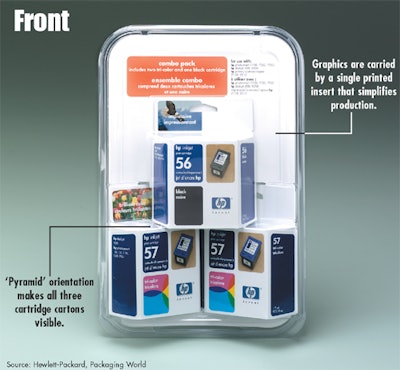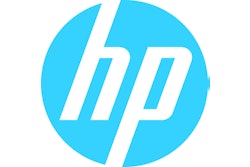Hewlett-Packard Co., Boise, ID, hopes to ink new sales with the nationwide October launch of a trio of ink-jet cartridges in a pack designed specifically for club stores.
The polyvinyl chloride thermoforms molded by Display Pack (Grand Rapids, MI) from 18-mil sheet contain three HP print cartridges. A “footpad” allows it to stand upright. A 16-pt white clay-coated paperboard sheet, made of recycled paper, is offset-printed by Display Pack in five colors. HP refers to the format internally as the “Tripack.”
There are three products in the line: two combinations of color and black cartridges, and a pack of three black cartridges. The Tripacks complement HP’s line of 9 ink-jet cartridge thermoformed twinpacks already sold in clubs. To meet club stores’ mandate to limit display space, the new packs’ width and length measurements match those of the twin-packs. The design also unifies the displays, according to Hajung Kim-Gifford, HP’s packaging engineer who designed the package in collaboration with her supervisor, Andrea Lantz, customization manager.
“This offers a multipack option for club stores, and provides consumers a better value in a design that’s quite attractive,” says Kim-Gifford. Product pricing varies by retailer, which includes Sam’s, Costco, and BJ’s.
Kim-Gifford points out that clubs were involved in the package’s design review process. For one thing, the package was designed to deter theft through its size and the need for a tool, such as scissors, to open it; thus, the package cannot be easily concealed or opened by hand.
Sealed clamshells or thermoforms, used for a range of consumer products, can be notoriously difficult to open. Yet, the Tripacks offer an “easy open” feature for consumers. That’s done through channels molded at select areas along the top edge of the clamshell that make it easier for the package to be cut open. Cutting through at one of the channels rather than in a raised area allows a consumer to easily cut onto the flat surface of the thermoform. “Other clamshells are displayed differently, and require strong edges that make the package difficult to cut open,” Kim-Gifford points out. “A knife or scissors can easily cut through this.”
HP selected cost-efficient PVC for its durability and clarity that permits consumers to view the contents. However, HP discloses that it is assessing alternative materials that are more environmentally friendly and still meet club stores’ packaging requirements.
Pyramid scheme
One package challenge that HP faced was in trying to fit three cartridges within the same dimensions of a twin-pack and also make it easy for consumers to see which cartridges were enclosed. HP accomplished this with a “pyramid” orientation in which two of the cartridges are angled facing inward with the third stacked on top.
Another challenge was the design of the insert card. It was necessary for it to cover the UPC codes of each cartridge so that the individual cartridges are not accidentally scanned at checkout. At the same time, crucial on-cartridge information such as country of origin and install-by dates needed to be viewable. HP achieved this through two “swing doors” on the insert card. “We maximized the space that was available for the insert,” says Kim-Gifford. The insert is made of a single piece of paperboard, which simplifies production. It is ingeniously die-cut and folded to fit around the cartridge cartons, with each of the three cartons’ printed country of origin and use-by date visible to consumers via a small cutout section of the insert.
The blister packaging operations are at the company’s plant in Chester, VA.



























